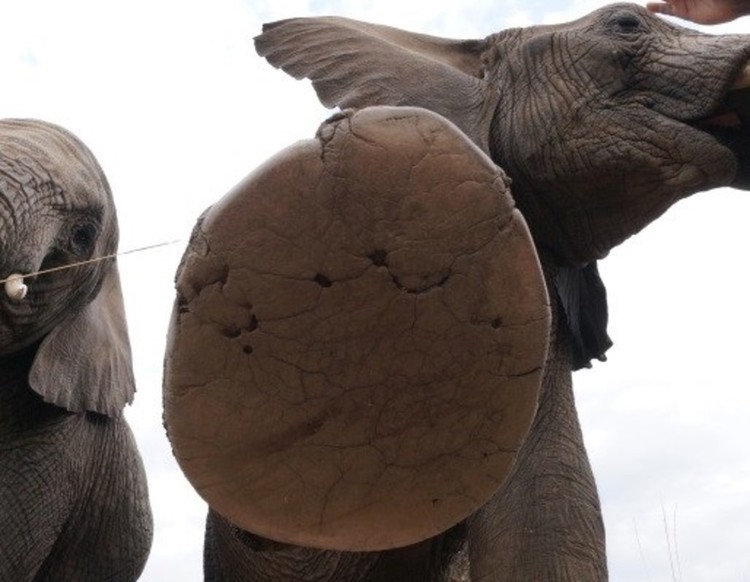 Olga Panagiotopoulou Correspondent —
Olga Panagiotopoulou Correspondent —
Women across the world understand the pain that comes with wearing a new pair of high heels. Any person who spends all day standing at work will also know how taxing it can be on the feet if you’re wearing the wrong shoes. So stop for a moment to consider how elephants feel.
Elephants are the largest living terrestrial mammals. Their feet carry that huge body mass of around eight tonnes, in the case of African elephants. To achieve this weight-bearing duty, elephant feet have peculiar structures that can also be seen in other large-bodied animals like rhinoceroses.
A close-up of the elephant foot shows elephants have five toes, the tips of which are in contact with the ground. They also have a large fat pad – equivalent to the human heel – that fills the shape behind the toes.
The pad has the ability to spread out and potentially reduce pressure when the foot hits the ground, similar to the human heel in barefoot runners. Elephants also have enlarged false toes, or predigits, that are embedded on the pads. These also ensure pressure is shifted from the sole to the rest of the limb.
Fossils of large bodied animals show a noticeable correlation between body weight, the posture of the toes and the development of the fat pad. Approximately 40 million years ago, elephants had small body masses (less than 2 000 kilogrammes) and their toes were flat.
As elephants started growing bigger than 2 000kgs they adopted more upright toes, larger fat pads and predigits. The assumption is that the fat pad developed in large-bodied land animals like elephants as a mechanism to reduce foot pressure, while supporting their large body mass.
The pad works well for elephants living in natural environments with ample space to move and forage. In the wild, elephants exercise their feet by walking on rocks, digging around and by rubbing their fat pads against the ground.
These activities keep their feet moist and their fat pads stay supple. They also serve as natural pedicures, trimming elephant’s heels. But this isn’t true of elephants kept in captivity. As a result they suffer excessively from various feet ailments which often turn out to be fatal.
Problems in captivity
Research on elephants kept in semi-natural habitats has shown that both Asian and African species concentrate the lowest pressures underneath the fat pad and the highest pressures on the outside part of their feet.
The reduction of foot pressure underneath the fat pad can be attributed to the compliance of the pad which potentially functions as a shock absorber and pressure distributor.
Elephants are often kept in captive enclosures to protect them against poachers and as tourist attractions. But animals kept in enclosures with hard grounds (like concrete or tarmac) and small spaces can’t exercise their feet.
Hard surfaces with floors covered in urine and faeces can cause infections around the pad. A cracked or infected fat pad can’t absorb pressure effectively making the outside part of the foot more prone to diseases.
The most common problems are toe-nail cracks, sole over-growth, trauma, osteomyelitis, ankylosis of the joints and osteoarthritis. It is estimated that 50 percent of captive elephant deaths are caused by these afflictions.
A recent study in Asian and African elephants in north American zoos estimated that elephants exposed to hard surfaces for four hours each day were more likely to develop joint stiffness or lameness.
This was compared to those exposed to hard surfaces for 2,5 hours per day. Another study into the quality of zoos in the UK found that 80,4 percent of a sample of elephants kept in enclosures with hard ground had foot problems ranging from cracks to infection.
Managing foot diseases is challenging because they often only become evident when they have progressed to incurable stages. Diagnostic techniques like imaging are expensive and in most cases require general anaesthesia.
Imaging or other hands-on methods are also impractical in most situations.
Solutions
There are a few things that can be done to keep the feet of captive elephants healthy. Wherever feasible, enclosures should try and replicate the environment of a natural habitat and reduce an elephant’s exposure to hard surfaces.
Foot trimming is a popular foot care method to remove cracks and divots when elephants walk in less natural habitats. But trimming protocols vary and their effect is still unknown.
Pressure platforms – electronic systems with sensors that measure foot pressure during dynamic (walking) or static (standing) activities – are one way to go.
They could be used to help keepers make better and more informed decisions to avoid affecting the mechanics of the elephant’s foot.
These pressure plates could also be used as a diagnostic tool so that foot diseases are picked up earlier, just as podiatrists use pressure mapping to diagnose and treat human foot disorders.
Implementing these practical measures would help ensure that elephants held in captivity don’t suffer undue stress and pain. – Conversation Africa.
Olga Panagiotopoulou, Lecturer in Anatomy, The University of Queensland
